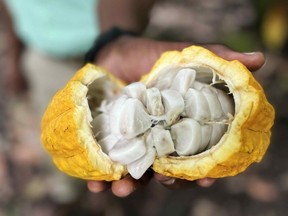A tour of chocolate labs and cacao-inspired cuisine on the Caribbean island of St. Lucia

Reviews and recommendations are unbiased and products are independently selected. Postmedia may earn an affiliate commission from purchases made through links on this page.
By Adam Waxman
Recommended Videos
Saint Lucia is an aphrodisiac.
Seven times British, seven times French, the temptress of the Caribbean, Helen of the West, wears a lush green mountainous crown, bejewelled by coral reefs and an oasis of tropical fruit and spice.

The most seductive allure of Saint Lucia is its chocolate. It seems that every resort is equipped with its own chocolate lab for us to create our own bars. Typically, Criollo and Forastero cacao are used. (Cacao refers to the raw organic matter which, after being ground and roasted, becomes Cocoa.) The quality and flavour profiles of their blends are distinguished by the island’s terroir. It is volcanic. Saint Lucia is pocked with lava domes and craters, and endowed with rich soil that enables vibrant fruit. Its most famous landmarks, the Pitons, are actually two gargantuan volcanic plugs towering out of the sea, looming like gods from every angle and enchanting all, from locals to Oprah. Long ago, Gros Piton and Petit Piton were worshipped as gods of provisions and fertility.

Inside the chocolate lab, I sample exquisite chocolate with notes of fruit from the surrounding orchards as well as hints of cinnamon, nutmeg and bay leaves. I have never tasted chocolate like this before. Ladling semi-liquid chocolate onto a marble table, my task is to temper it and then mold it into a bar to which I then add a sprinkling of cocoa nibs, coconut and sea salt.


On a shaded terrace we learn about the unique earthy flavour that fermentation provides Saint Lucian chocolate. We stand at our individual stations with mortar and pestle in hand, and shadow our hilarious and zealously pound-happy guide, Merle. I follow along as best I can to pound cocoa until it becomes paste and my arms become mush. Try as I might, Merle is dissatisfied with my pounding. She takes over to help me out. Step by step I achieve my desired taste and sweetness, mold it into a bar, and then shuffle off to the fields to learn the life cycle and process of cacao.
Beginning in the seedery, we graft our very own cacao plants. There they will stay for six months before being planted somewhere on the grounds. All different kinds of herbs are grown here. We’re told, “Grow what you eat and eat what you grow.” They even have a boutique coffee production in which they dry, shell, wash and hull coffee beans. Back at the food court, we indulge in their beautifully rich espresso while overlooking the fields where the coffee is harvested.


The ingredient base of Saint Lucian cuisine is a great palette to work with. Creole, Jerk and West Indian Spices of cinnamon, ginger root, cloves, nutmeg and allspice are just the base. There are over one hundred spices and herbs used in Caribbean cooking that make each dining experience here dynamic. Adding to those spice combinations, pairings with the island’s fruits and chocolate opens up endless possibilities for harmonious flavour profiles. Saint Lucia is indeed an island of romance. It starts in the garden, is revealed on the plate, and seduces us with aromas and flavours that make up the spice of life.